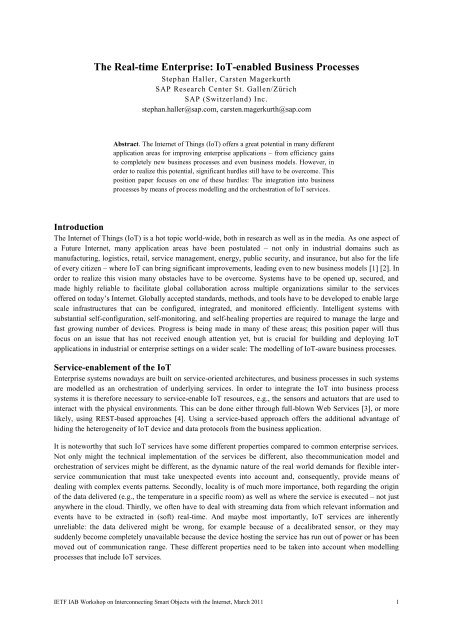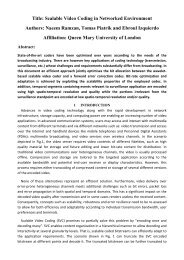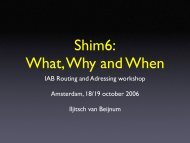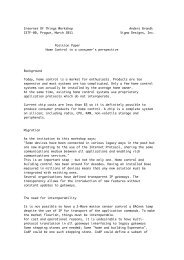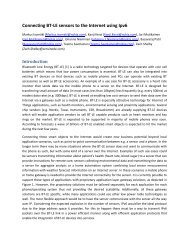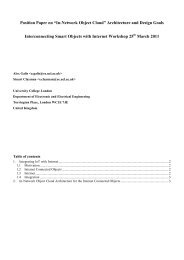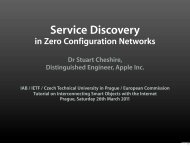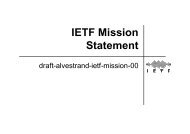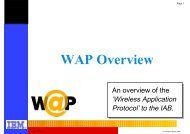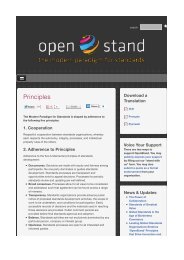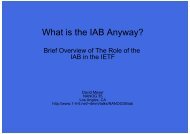The Real-time Enterprise - Internet Architecture Board
The Real-time Enterprise - Internet Architecture Board
The Real-time Enterprise - Internet Architecture Board
Create successful ePaper yourself
Turn your PDF publications into a flip-book with our unique Google optimized e-Paper software.
<strong>The</strong> <strong>Real</strong>-<strong>time</strong> <strong>Enterprise</strong>: IoT-enabled Business Processes<br />
Stephan Haller, Carsten Magerkurth<br />
SAP Research Center St. Gallen/Zürich<br />
SAP (Switzerland) Inc.<br />
stephan.haller@sap.com, carsten.magerkurth@sap.com<br />
Abstract. <strong>The</strong> <strong>Internet</strong> of Things (IoT) offers a great potential in many different<br />
application areas for improving enterprise applications – from efficiency gains<br />
to completely new business processes and even business models. However, in<br />
order to realize this potential, significant hurdles still have to be overcome. This<br />
position paper focuses on one of these hurdles: <strong>The</strong> integration into business<br />
processes by means of process modelling and the orchestration of IoT services.<br />
Introduction<br />
<strong>The</strong> <strong>Internet</strong> of Things (IoT) is a hot topic world-wide, both in research as well as in the media. As one aspect of<br />
a Future <strong>Internet</strong>, many application areas have been postulated – not only in industrial domains such as<br />
manufacturing, logistics, retail, service management, energy, public security, and insurance, but also for the life<br />
of every citizen – where IoT can bring significant improvements, leading even to new business models [1] [2]. In<br />
order to realize this vision many obstacles have to be overcome. Systems have to be opened up, secured, and<br />
made highly reliable to facilitate global collaboration across multiple organizations similar to the services<br />
offered on today’s <strong>Internet</strong>. Globally accepted standards, methods, and tools have to be developed to enable large<br />
scale infrastructures that can be configured, integrated, and monitored efficiently. Intelligent systems with<br />
substantial self-configuration, self-monitoring, and self-healing properties are required to manage the large and<br />
fast growing number of devices. Progress is being made in many of these areas; this position paper will thus<br />
focus on an issue that has not received enough attention yet, but is crucial for building and deploying IoT<br />
applications in industrial or enterprise settings on a wider scale: <strong>The</strong> modelling of IoT-aware business processes.<br />
Service-enablement of the IoT<br />
<strong>Enterprise</strong> systems nowadays are built on service-oriented architectures, and business processes in such systems<br />
are modelled as an orchestration of underlying services. In order to integrate the IoT into business process<br />
systems it is therefore necessary to service-enable IoT resources, e.g., the sensors and actuators that are used to<br />
interact with the physical environments. This can be done either through full-blown Web Services [3], or more<br />
likely, using REST-based approaches [4]. Using a service-based approach offers the additional advantage of<br />
hiding the heterogeneity of IoT device and data protocols from the business application.<br />
It is noteworthy that such IoT services have some different properties compared to common enterprise services.<br />
Not only might the technical implementation of the services be different, also thecommunication model and<br />
orchestration of services might be different, as the dynamic nature of the real world demands for flexible interservice<br />
communication that must take unexpected events into account and, consequently, provide means of<br />
dealing with complex events patterns. Secondly, locality is of much more importance, both regarding the origin<br />
of the data delivered (e.g., the temperature in a specific room) as well as where the service is executed – not just<br />
anywhere in the cloud. Thirdly, we often have to deal with streaming data from which relevant information and<br />
events have to be extracted in (soft) real-<strong>time</strong>. And maybe most importantly, IoT services are inherently<br />
unreliable: the data delivered might be wrong, for example because of a decalibrated sensor, or they may<br />
suddenly become completely unavailable because the device hosting the service has run out of power or has been<br />
moved out of communication range. <strong>The</strong>se different properties need to be taken into account when modelling<br />
processes that include IoT services.<br />
IETF IAB Workshop on Interconnecting Smart Objects with the <strong>Internet</strong>, March 2011 1
S.Haller, C.Magerkurth<br />
<strong>The</strong> <strong>Real</strong>-<strong>time</strong> <strong>Enterprise</strong>: IoT-enabled Business Processes<br />
Modelling of IoT-aware Business Processes<br />
Currently, integrating IoT devices – RFID, sensors, actuators etc. – into enterprise systems requires a lot of<br />
engineering, deployment and configuration of middleware, as well as some custom development. Every new<br />
installation requires again a significant effort. On the other hand, Business Process Modelling (BPM) is an<br />
established technique for modelling and executing complex processes in enterprises. If now these techniques<br />
could also be used for IoT-aware processes, a significant step towards wider deployment of IoT technologies<br />
would be made. In fact, one can even say this is an absolute requirement, since many enterprises rely on BPM<br />
for their processes.<br />
However, current business process modelling is geared towards planned and deterministic processes. <strong>The</strong> related<br />
tools don’t yet support the challenges that IoT-aware processes bring well. <strong>The</strong> challenges include:<br />
Adaptive and event-driven processes: One of the main benefits of IoT integration is that processes become<br />
more adaptive to what is actually happening in the real world. Inherently, this is based on events that are either<br />
detected directly or by real-<strong>time</strong> analysis of sensor data. Such events can occur at any <strong>time</strong> in the process. For<br />
some of the events, the occurrence probability is very low. But one knows that they might occur, but not when or<br />
if at all. Modelling such events into a process is cumbersome, as they would have to be included into all possible<br />
activities, leading to additional complexity and making it more difficult to understand the modelled process, in<br />
particular the main flow of the process (the 80% case). Secondly, how to react on a single event can depend on<br />
the context, i.e. the set of events that have been detected previously. A simple example: If people had entered a<br />
certain area, and later a sharp rise in temperature is detect there, as well as smoke, then the rescue team needs to<br />
be sent. Or, if the truck is delayed so that the delivery cannot reach the intended B customer in <strong>time</strong>, and if the<br />
company just has received an urgent order from its preferred A customer, then the truck is rerouted to the A<br />
customer.<br />
Processes dealing with unreliable data: When dealing with events coming from the physical world (e.g., via<br />
sensors), a degree of unreliability and uncertainty is introduced into the processes. If decisions in a business<br />
process are to be taken based on events that have some uncertainty attached, it makes sense to associate each of<br />
these events with some value for the quality of information (QoI). In simple cases, this allows then the process<br />
modeller to define thresholds: e.g., if the degree of certainty is more than 90%, then it is assumed that the event<br />
really happened. If it is between 50% and 90%, some other activities will be triggered to determine if the event<br />
occurred or not. If it is below 50%, the event is ignored. Things get more complex when multiple events are<br />
involved: E.g., one event with 95% certainty, one with 73%, and another with 52%. <strong>The</strong> underlying services that<br />
fire the original events have to be programmed to attach such QoI values to the events. From a BPM perspective,<br />
it is though required that such information can be captured, processed and expressed in the used modelling<br />
notation language, e.g. BPMN. Secondly, the syntax and semantics of such QoI values need to be standardized:<br />
Is it a simple certainty percentage as in the examples above, or should it be something more expressive (e.g., a<br />
range within which the true value lies)?<br />
Processes dealing with unreliable resources: Not only the data from resources is inherently unreliable, but also<br />
the resources providing the data themselves, e.g., due to the failure of the hosting device. Processes relying on<br />
such resources need to be able to adapt to such situations. <strong>The</strong> first issue is to detect such a failure at all: In the<br />
case that a process is calling a resource directly, this detection is trivial. When we’re talking about resources that<br />
might generate an event at one point in <strong>time</strong> (e.g., the resource that monitors the temperature condition within the<br />
truck and sends an alert if it has become too hot), it is more difficult: Not having received any event can be<br />
because of resource failure, but also because there was nothing to report. Some monitoring software is needed to<br />
detect such problems; it is unclear though if such software should be part of the BPM execution environment or<br />
should be a separate component.<br />
Highly distributed processes: When interaction with real-world objects and devices is required, it can make<br />
sense to execute a process in a decentralized fashion. As stated in [1], the decomposition and decentralization of<br />
existing business processes increases scalability and performance, allows better decision making and could even<br />
lead to new revenue streams through entitlement management of software products deployed on smart items.<br />
For example, in environmental monitoring or supply chain tracking applications, no messages need to be sent to<br />
the central system as long as everything is within the defined limits. Only if there is a deviation, and alert (event)<br />
needs to be generated, which in turn can lead to an adaptation of the overall process. From a business process<br />
IETF IAB Workshop on Interconnecting Smart Objects with the <strong>Internet</strong>, March 2011 2
S.Haller, C.Magerkurth<br />
<strong>The</strong> <strong>Real</strong>-<strong>time</strong> <strong>Enterprise</strong>: IoT-enabled Business Processes<br />
modelling perspective though, it should be possible to define the process centrally, including the fact that some<br />
activities (i.e., the monitoring) will be done remotely. Once the complete process is modelled, it should then be<br />
possible to deploy the related services to where they have to be executed, and then run and monitor the complete<br />
process.<br />
Conclusion<br />
Integrating <strong>Internet</strong> of Things aspects into Business Process Modelling and related tools is one of the key<br />
challenges that need to be overcome in order to see wider deployment of IoT technologies, and thus, to be able to<br />
reap the many potential benefits that have been postulated for the IoT. When doing so, the special characteristics<br />
of IoT services and processes have to be taken into account and likely existing business process modelling and<br />
execution languages like BPMN [5] and WS-BPEL [6], as well as service description languages like USDL [7],<br />
need to be extended.<br />
Regarding the modelling of distributed processes, in a first step it should be possible to define in the modelling<br />
environment which activities should be executed where, and to select the services that implement these remote<br />
activities. It has to be noted though that these services – as they are implemented on resource-constrained<br />
devices – are often not based on SOAP, but rather use REST. A second and more advanced step is then to use<br />
the model also for the deployment of the services: All required services are if necessary deployed to the target<br />
devices/environments once the model is instantiated, or even a complete subprocess is deployed to a remote<br />
BPM execution engine. In addition, it would also be desirable to support the business process modeller in<br />
deciding what activities should be executed where, initially through guidelines, later maybe even through (semi-)<br />
automatic decomposition.<br />
Acknowledgments. This paper describes work undertaken in the context of the IoT-A project, ‘<strong>Internet</strong> of<br />
Things – <strong>Architecture</strong>’ (http://www.iot-a.eu/i). IoT-A is an Integrated Project supported by the European 7th<br />
Framework Programme, contract number: 257521. <strong>The</strong> authors would also like to thank the other colleagues<br />
working on <strong>Internet</strong> of Things topics at SAP Research, in particular Jochen Rode, Sonja Meyer, and Klaus<br />
Sperner.<br />
References<br />
[1] S. Haller, S. Karnouskos, and C. Schroth, “<strong>The</strong> <strong>Internet</strong> of Things in an <strong>Enterprise</strong> Context”, in J.<br />
Domingue, D. Fensel und P. Traverso (Eds.), “First Future <strong>Internet</strong> Symposium - FIS 2008”, LNCS 5468,<br />
Springer Verlag 2009, pp. 14-28.<br />
[2] O. Vermesan, M. Harrison, H. Vogt, K. Kalaboukas, M. Tomasella et al. (Eds.), “<strong>The</strong> <strong>Internet</strong> of Things -<br />
Strategic Research Roadmap”, Cluster of European Research Projects on the <strong>Internet</strong> of Things, CERP-IoT,<br />
2009.<br />
[3] W3C, Web Services <strong>Architecture</strong>, http://www.w3.org/TR/ws-arch/, last accessed: February 2, 2011<br />
[4] D. Guinard, V. Trifa, E. Wilde, “A Resource Oriented <strong>Architecture</strong> for the Web of Things”, in Proceedings<br />
of <strong>Internet</strong> of Things 2010 International Conference (IoT 2010). Tokyo, Japan, November 2010.<br />
[5] OMG, Business Process Model and Notation specification, available at<br />
http://www.omg.org/technology/documents/br_pm_spec_catalog.htm, last accessed: February 9, 2011-02-09<br />
[6] OASIS, Web Services Business Process Execution Language, http://docs.oasis-open.org/wsbpel/2.0/wsbpelv2.0.html,<br />
last accessed: February 9, 2011<br />
[7] W3C, Unified Service Description Language Incubator Group, http://www.w3.org/2005/Incubator/usdl/, last<br />
accessed: February 9, 2011<br />
IETF IAB Workshop on Interconnecting Smart Objects with the <strong>Internet</strong>, March 2011 3


